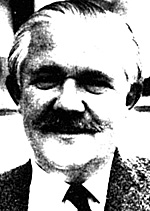 Justly renowned in World War II as a prominent Commando leader
(commanded No. 3 Commando) Peter Young took part in the raids on
Europe at Guersey (1940), the Lofoten Islands and Vaagso (1941) and
Dieppe (1942). He was in the first landings in Sicily and Italy and
served in Normandy from D-Day besides taking part in the last Arakan
Campaign. He also commanded a battalion of the Arab Legion after the
war and is the author of many authoratative books on military history
(see Wargamer's Newsletter August, 1972).
Justly renowned in World War II as a prominent Commando leader
(commanded No. 3 Commando) Peter Young took part in the raids on
Europe at Guersey (1940), the Lofoten Islands and Vaagso (1941) and
Dieppe (1942). He was in the first landings in Sicily and Italy and
served in Normandy from D-Day besides taking part in the last Arakan
Campaign. He also commanded a battalion of the Arab Legion after the
war and is the author of many authoratative books on military history
(see Wargamer's Newsletter August, 1972).
Thomas Ackerman of Ontario, Canada, wrote the following letter to both Brigadier Young and Lt. Colonel James P. Lawford M.C. Their respective answers form the "Guest of the Month" contribution for this and next month).
- "I am a novice wargamer, having fought a number of battles I have found that the psychological factor is missing from the game. I believe this can be redressed by conducting a campaign which is concluded by a battle.
Knowing that wargames are in your military realm, I am writing to enquire for a detailed explanation of the steps and procedure involved in the mental calculation by a military commander in planning a military campaign. An example of each step and procedure would be most helpful."
"Dear Thomas Ackerman,
Thank you for your letter of 24 July. I do not know if you have seen my book CHARGE: Or How to play War Games. In it I deal with the question of Morale, the pschological side of which you speak.
Of course, I realise that troops can only take so much punishment, and seldom really fight it out to the last man -- though one can think of instances in the French Foreign Legion, in the Zulu Wars, in the Japanese Army etc., of this being done. But in wargame armies it is usual to rule that a unit which has lost, say, 50% is out of action. One can also alter the scale for very bad troops or very good ones. If, for example, one has a prejudice against the Spanish Army of 1808, one can rule that their regiments go out of action when they have only had 40% casualties. And so on.
So much for the troops. Now for the commanders. These are in fact the players themselves. It is true that they seldom got bit, or terrified by shell-fire, nevertheless the whole game is devised to present them with the doubts, if not the fears, that affect real commanders. For them the psychological side is represented by the need to foresee an enemy's moves, to devise good plans; to know when to stick to the They must also steel themselves against the loaded comments of a critical opponent.
The more you bring morale factors into the Game where the troops are concerned, the more you diminish the clash between the talents and personalities of the actual real-life players. But is this what you want? Do you want to pit your wits against an opponent and beat him in fair fight, or do you want him to hide behind his bad luck, which dictated that you threw too many sixes and wiped out his feeble-minded plastic host in record time?
It would take me six months to answer your letter properly. I recommend to you a book called The Art of War on Land, by the late Lt.-Colonel A.H.Burne D.S.O., who was a very good strategist. Also The Transformations of War by Commandant J. Colin, London, Hugh Rees Ltd., 1912.
Other things being equal, training, material, numbers, etc., roughly balanced, one makes one's plans by collecting the maximum amount of information one can about the enemy's strength, plans, movements and dispositions. One then asks oneself the question: If I were in his position what would I lead with? One then makes a plan which, whilst incorporating a large measure and Deception, places your forces exactly where the enemy least wants to see them.
I need scarcely add that vigour, speed and audacity should inspire your every move.
Back to Table of Contents -- Wargamer's Newsletter # 131
To Wargamer's Newsletter List of Issues
To MagWeb Master Magazine List
© Copyright 1973 by Donald Featherstone.
This article appears in MagWeb.com (Magazine Web) on the Internet World Wide Web.
Other articles from military history and related magazines are available at http://www.magweb.com